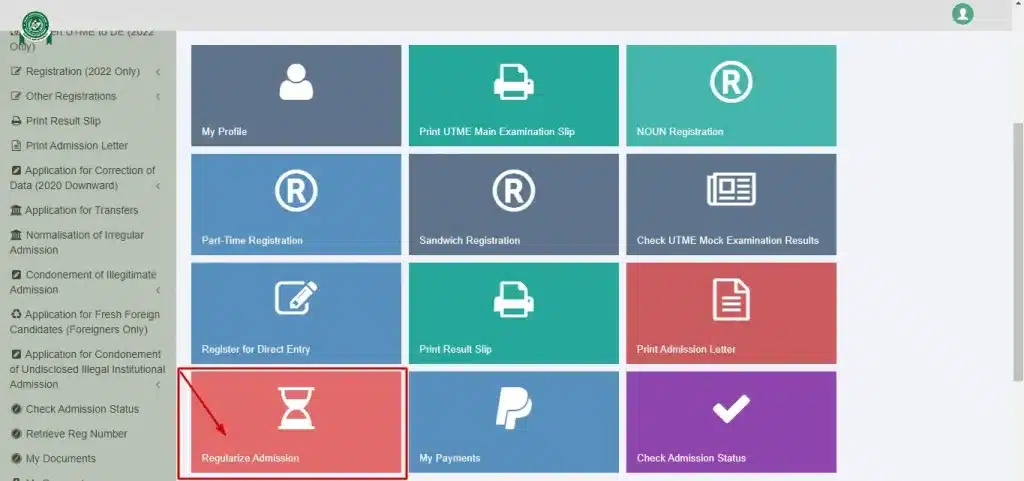JAMB regularization, also called JAMB Late Application, allows students in any school without a JAMB registration number to apply. The cost is ₦10,000.
JAMB regularization helps students fix mistakes in their school records, like errors or differences.
This process helps them resolve these problems and keep studying without any trouble.
Table of Contents
The primary purposes of JAMB regularization/ JAMB Late Application
The Key Purposes of JAMB Regularization include the following:
1. Validation of Academic Records: JAMB regularization authenticates and legitimizes students’ academic records, confirming the legitimacy of their previous educational experiences.
2. Obtaining a JAMB Registration Number: In certain cases, students may have pursued studies without initially acquiring a JAMB registration number, a vital requirement for admission to Nigerian tertiary institutions. Regularization enables them to obtain this essential credential.
3. Ensuring Eligibility for Higher Education: Regularization is often the initial step to qualifying for admission into higher institutions. Without a valid JAMB record, students may be ineligible for various undergraduate programs.
4. Avoiding Disqualification: Regularization prevents the risk of disqualification during the admission process for students with discrepancies in their records. It eliminates obstacles that could hinder their pursuit of higher education.
What is JAMB Regularization ?
JAMB regularization, also known as JAMB Late Application, is a formal way for students to fix and make official their academic records with the Joint Admissions and Matriculation Board.
This process helps correct any mistakes or problems in their education history, making sure their records are trustworthy and valid.
The Significance of JAMB Regularization/ JAMB Late Application
JAMB Late Application holds great importance in the Nigerian education system, influencing students in several ways:
1. Ensuring Academic Trustworthiness: At its core, the regularization is about making sure a student’s academic journey is credible. It tells educational institutions that a student’s records are accurate, maintaining the integrity of the academic system.
2. Opening Doors to Higher Education: For many students, the regularization is the key to higher education. It allows them to enter undergraduate programs by confirming they have the necessary JAMB registration number, a crucial requirement for admission.
3. Avoiding Disqualification: Without regularization, students with discrepancies in their records may be disqualified during the admission process.
Regularization acts as a protective shield, preventing the unfortunate situation of being considered ineligible due to record-related issues.
4. Supporting Professional Growth: JAMB regularization goes beyond undergraduate education. It helps students pursue postgraduate studies and attain various professional certifications that often require a clean and validated academic history.
When and Why Students Need JAMB Late Application
Students might need the JAMB Late Application for a few reasons:
1. Incomplete JAMB Registration: Some students start their education without getting a JAMB registration number. To fix this and make their academic progress official, they need to go through regularization.
2. Issues in Records: Mistakes in academic records, like wrong names or birthdates, require regularization to correct them.
3. Change of Institution: Students switching schools or programs may need regularization to make sure their educational history is accurate.
4. Late Registration: If students register with JAMB late, they need regularization to align their records with the board’s rules.
Who Needs JAMB Regularization/JAMB Late Application?
Read More: All You Need To Know About JAMB CAPS: A Comprehensive Guide to JAMB CAPS Portal In 2024
JAMB regularization is an important step for certain students in Nigeria’s education system.
To explain it better, let’s figure out who needs the regularization and look at the situations when it’s really necessary.
Target Audience for JAMB Regularization/JAMB Late Application
The primary target audience for the JAMB Late Application includes:
1. Prospective University Students: This group comprises students who aspire to gain admission into Nigerian universities or other tertiary institutions.
These students may have discrepancies in their academic records that need rectification before they can proceed with their higher education journey.
2. Students with Incomplete JAMB Registration: Individuals who initiated their educational journey without obtaining a JAMB registration number fall within this category.
Regularization is essential for them to secure this vital credential and ensure eligibility for university admission.
3. Transfer Students: Students who have transferred from one institution to another or shifted between academic programs may require regularization to harmonize their academic records with their new educational path.
4. Late Registrants: Some students may have registered for JAMB later than the recommended timeframe. Regularization is necessary to align their registration with the academic calendar and requirements.
Common Situations Requiring JAMB Late Application
Now, let’s explore the common scenarios where students find themselves in need of JAMB regularization:
1. Missing JAMB Registration Number: Students who commence their academic path without obtaining a JAMB registration number must undergo regularization to secure this crucial identifier.
2. Change of Personal Information: If students discover mistakes in their details, like incorrect names, birthdates, or contact information, JAMB regularization becomes necessary to rectify these errors.
3. Incomplete Academic Records: Records with missing qualifications or wrongly recorded grades require JAMB regularization to ensure the student’s complete academic history is accurately represented.
4. Transfers and Program Changes: Students who transfer between institutions or switch academic programs need regularization to update their records, indicating the new institution or program of study.
5. Late Registration: Some students might register for JAMB after the set deadline, requiring regularization to align their registration with the board’s guidelines.
6. Validation for Postgraduate Studies: Those aiming for postgraduate studies often require JAMB regularization to verify their previous academic records, a requirement for many advanced educational programs.
The JAMB Regularization Procedure
The JAMB regularization process is a carefully organized method made to help Nigerian students fix mistakes and confirm their academic records.
It’s a step-by-step process that makes sure students’ education histories are correct and acknowledged by the Joint Admissions and Matriculation Board (JAMB).
Let’s break it down into five simple steps to make it easier to understand.
Step 1: Obtaining the JAMB Late Application Form
To start the regularization process, get the Regularization Form. You can pick it up at any JAMB office or authorized CBT (Computer-Based Test) center.

Find out where to get the form by checking the official JAMB website or asking at your school. Make sure to get the latest form to follow the current rules.
Step 2: Filling Out the Form Correctly
Once you have the Form, fill it out carefully and accurately. Double-check your details, academic history, and other information. Fix any mistakes now to avoid problems later. If you’re unsure, ask for help from school counsellors or staff.

Step 3: Gather Required Documents
i. O’Level Result: Copies of your O’Level result (WAEC, NECO, or its equivalent) to substantiate your academic qualifications.
ii. Birth Certificate: A copy of your birth certificate or affidavit to verify your date of birth.
iii. Passport Photograph: Recent passport-sized photographs, usually with specific dimensions, as specified by JAMB.
iv. Change of Admission Letter: If you have transferred institutions or programs, a change of admission letter from your current institution is necessary to update your records.

Make sure everything is clear and organized.
Step 4: Submitting and Paying
Once your form is filled out and the documents are ready, submit them to the JAMB office or an authorized CBT center.

Stick to any deadlines from your school. Usually, you’ll need to pay a processing fee. Pay it the right way, and keep copies of your payment proof and any acknowledgement slips they give you.
Step 5: Confirmation and Acknowledgment
After you submit your JAMB Regularization Form and documents, you’ll get an acknowledgement slip or receipt. This paper confirms that your regularization process has started.

Keep this slip safe because it has important details like your transaction reference number and how long the process might take.
Now, JAMB officials will check your documents and make sure they match your academic history. Stay alert for any messages or updates from JAMB during this time. If there are any issues, it’s important to deal with them as soon as possible.
Benefits of JAMB Late Application
JAMB regularization, despite being viewed mainly as a procedural necessity, brings numerous advantages that greatly affect students in Nigeria.
Beyond just dealing with paperwork and administrative tasks, this process has significant benefits for those who go through it.
In this part, we will explain how JAMB regularization can strongly help students and emphasize the crucial importance of having a valid JAMB registration number.
1. Confirming Academic Achievements
JAMB regularization primarily ensures that academic records are valid. For students, this means that their educational accomplishments become credible and genuine.
Going through this process guarantees official recognition of their qualifications, validating the years of effort they put into their studies.
2. Entry to Higher Education
One of the immediate and crucial benefits of JAMB regularization is that it allows access to higher education.
A valid JAMB registration number is often a must-have for admission into Nigerian universities and other advanced institutions.
Without it, students might miss out on various undergraduate programs, putting their pursuit of higher education on hold.
3. Prevention of Disqualifications
In the competitive world of university admissions, any issues in academic records can lead to disqualification. JAMB regularization acts as a safeguard against such disqualifications.
It resolves record-related problems, ensuring students are not unfairly kept from pursuing their chosen courses of study.
4. Improved Career Opportunities
A valid JAMB registration number is not only crucial for undergraduate admissions but also plays a key role in shaping future career opportunities.
Postgraduate studies, professional certifications, and job applications often require a clean and validated academic history.
JAMB regularization ensures students are well-prepared for these opportunities.
5. Avoidance of Academic Obstacles
Regularization helps students sidestep potential obstacles in their academic journey. It prevents last-minute rushes to obtain a JAMB registration number, which can cause stress and delays.
By addressing the regularization process proactively, students make their path to higher education smoother.
6. Ensuring Fairness and Responsibility
JAMB regularization supports fairness and responsibility within the educational system. It ensures that all students are on an equal footing, with verified and accurate records. This, in turn, upholds the integrity of the entire education system.
7. Confirmation of Qualifications
For careers with strict qualification checks, like teaching or certain government positions, JAMB regularization is vital. It allows potential employers to verify the legitimacy of a candidate’s academic qualifications, building trust and confidence in the hiring process.
Common Mistakes to Avoid
Read More: JAMB Admission Status 2024: Easy Guide To Everything You Need to Know About Admission Status
Common Mistakes During JAMB Regularization and How to Avoid Them
1. Incomplete or Incorrect Form Submission
Mistake: Not submitting all required documents or inaccurately filling out the JAMB Regularization Form.
Tip to Avoid: Carefully review the form before submitting, ensuring all fields are correctly filled, and attach necessary documents following JAMB guidelines. Seek help from educational counselors or designated personnel if unsure.
2. Late Submission
Mistake: Waiting until the last minute to submit regularization documents and the form.
Tip to Avoid: Start early and meet submission deadlines set by your institution or JAMB. Late submissions may cause processing delays and missed admission opportunities.
3. Ignoring Communication from JAMB
Mistake: Neglecting to check emails or communication channels for updates from JAMB.
Tip to Avoid: Keep a close eye on your email, SMS notifications, or provided communication channels. Respond promptly to requests for additional information to speed up the process.
4. Inaccurate Personal Information
Mistake: Providing incorrect personal information on the JAMB Regularization Form.
Tip to Avoid: Double-check all personal details, such as name, date of birth, and contact information, for accuracy. Errors in personal information can complicate the validation process.
5. Failure to Verify Submission
Mistake: Not confirming that your submission has been received and acknowledged by JAMB.
Tip to Avoid: Keep copies of acknowledgment slips or receipts given upon submission. These documents serve as proof that your regularization process is underway and contain essential information like transaction reference numbers.
6. Procrastination
Mistake: Delaying or putting off starting the regularization process.
Tip to Avoid: Begin the process as soon as you realize you need regularization. Procrastination can cause unnecessary stress and might result in missed opportunities.
7. Misunderstanding JAMB Regulations
Mistake: Not understanding the specific requirements and rules set by JAMB.
Tip to Avoid: Read and understand JAMB’s official guidelines for regularization, usually available on their website. Make sure to follow these regulations throughout the entire process.
8. Inadequate Documentation
Mistake: Providing incomplete or insufficient documents to support your academic history.
Tip to Avoid: Collect all necessary documents, including O’Level results, birth certificate, and change of admission letter (if needed). Ensure they are clear, readable, and organized for submission.
9. Lack of Follow-Up
Mistake: Forgetting to check the progress of your regularization.
Tip to Avoid: Regularly check the status of your regularization with JAMB or your institution. This proactive approach helps you stay informed and deal with any potential issues promptly.
Being aware of these common mistakes and following the provided tips empowers students to navigate the JAMB regularization process with confidence, ensuring accurate validation of their academic records without unnecessary complications.
Frequently Asked Questions (FAQs) on JAMB Regularization
JAMB regularization can be a complex process, and students often have questions and concerns about it.
In this section, we aim to provide answers to some of the most frequently asked questions related to JAMB regularization while addressing common concerns and misconceptions.
Q1: What is JAMB Regularization, and Why Do I Need It?
JAMB regularization is a process to validate and regularize your academic records with the Joint Admissions and Matriculation Board (JAMB). You may need it if you have discrepancies in your academic history or if you don’t have a JAMB registration number, which is often required for university admission.
Q2: How Do I Obtain the JAMB Regularization Form?
You can obtain the JAMB Regularization Form from any JAMB office or accredited CBT center. Visit the official JAMB website or inquire at your institution to find the nearest authorized center for form collection.
Q3: What Documents Do I Need for JAMB Regularization?
Commonly required documents include copies of your O’Level result (e.g., WAEC, NECO), a birth certificate or affidavit, recent passport photographs, and a change of admission letter (if applicable). Verify the specific requirements based on your situation.
Q4: How Can I Ensure I Fill Out the Form Correctly?
Carefully review the JAMB Regularization Form before submission. Double-check all information for accuracy, and seek guidance from educational counselors or designated personnel if you have any doubts.
Q5: What Should I Do If I Miss the Submission Deadline?
It’s crucial to adhere to submission deadlines. If you miss the deadline, contact your institution or JAMB immediately to inquire about any available remedies or extensions. Late submissions may result in processing delays.
Q6: What Happens After I Submit the Regularization Form?
After submission, JAMB officials will review your documents and academic history. You will receive an acknowledgment slip or receipt confirming that your regularization is in progress. Keep this document safe for reference.
Q7: How Long Does the Regularization Process Take?
The processing time may vary, but it typically takes several weeks to months. Be patient and periodically check the status of your regularization with JAMB or your institution.
Q8: Can I Apply for University Admission While My Regularization Is in Progress?
It’s advisable to wait until your regularization is complete and you have a valid JAMB registration number before applying for university admission. Having a valid JAMB number ensures a smoother application process.
Q9: Can I Use the Same JAMB Registration Number for Postgraduate Studies?
Your JAMB registration number can be used for postgraduate studies. However, ensure that your academic records are up to date and validated through the regularization process.
Q10: Are There Any Fees Associated with JAMB Regularization?
Yes, there is usually a processing fee for JAMB regularization. Ensure that you make the necessary payment through approved channels and keep copies of payment receipts for your records.
Addressing Concerns and Misconceptions
1. Concern: Some students are worried that getting JAMB regularization done will take a long time and mess up their education plans.
Response: While it might take different amounts of time for different people, starting the regularization process early and keeping track of how it’s going can help avoid delays. Take charge of your education journey and stay on top of things.
2. Concern: People might think the regularization process is too complicated.
Response: JAMB has clear instructions on their official website about how to do regularization. If students follow these instructions and ask for help when they need it, they can go through the process without any problems.
3. Concern: Students might be scared that mistakes in their records will make them lose out on opportunities.
Response: The point of regularization is to fix mistakes and make sure students don’t miss out. It’s a way to help, not a roadblock, in getting higher education.
We want to answer these common questions and worries to help students understand and feel confident about the JAMB regularization process. Our goal is to make sure their academic records are checked accurately and without any unnecessary issues.
Conclusion
In this detailed guide, we’ve covered the ins and outs of JAMB regularization, explaining why it’s important and its crucial role in the Nigerian education system. Let’s summarize the main points we discussed:
1. What is JAMB Regularization: We defined JAMB regularization as the process of validating and organizing academic records with the Joint Admissions and Matriculation Board (JAMB).
2. Who Needs JAMB Regularization: We identified the people who should go through JAMB regularization, including those aiming for university admission, those with incomplete JAMB registration, transfer students, and late registrants.
3. Steps in the JAMB Regularization Process: We outlined the five necessary steps in the regularization process, from getting the form to confirmation and acknowledgment.
4. Benefits of JAMB Regularization: We highlighted the advantages, such as validating academic records, gaining access to higher education, avoiding disqualifications, improving career prospects, and more.
5. Common Mistakes to Avoid: We listed typical errors students make during regularization and offered tips on how to steer clear of them.
6. Frequently Asked Questions: We answered common questions about JAMB regularization, addressing concerns and clearing up misconceptions.
7. Additional Resources: We provided links to official JAMB websites and resources for more information.
We wish you success in your educational journey and hope this guide has been a helpful tool as you navigate the process of JAMB regularization.






